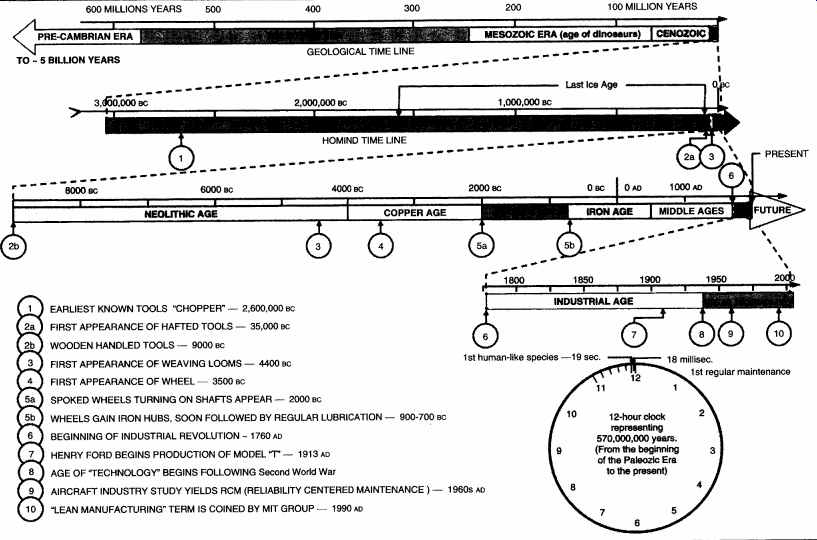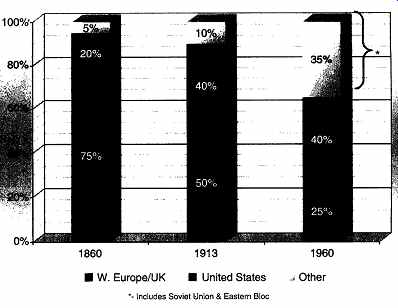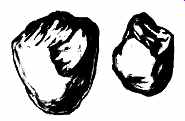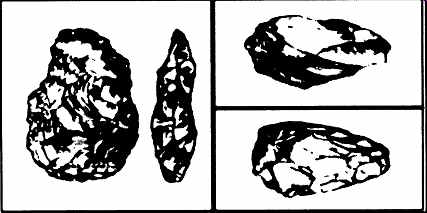AMAZON multi-meters discounts AMAZON oscilloscope discounts
In the greater scheme of things, maintenance has not been around very long. This was primarily because there was nothing to maintain for such a long, long time. A quick glance at FIG. 1 will illustrate that relative to the time elapsed since the creation of Earth, the practice of maintenance has been with us for an infinitesimal amount of time. When starting from the beginning of the Paleozoic Era and equating time to a 12-hour clock, real maintenance has only been around for about 18 milliseconds. With such a short period of existence, it stands to reason that there are still many lessons to learn on the quest for perfection in the practice of maintenance.
Even though the first tools were used by hominids (human and humanlike life forms; i.e., Australopithecus, Homo erectus and Homo sapiens), maintenance was slow to evolve. This is likely due to an extremely low level of intelligence in the earliest hominids. FIG. 2 provides a depiction of Homo erectus--decide for yourself if you think he could embrace the concepts of planned, proactive preventive and predictive maintenance technologies. It was not until the coming of the metal ages--the Copper Age, Bronze Age and Iron Age, and following the evolution of the wheel as it progressed from your basic log to a solid disk and then into the spoked wheel (with metal hubs to fit onto an axle) that any true form of maintenance really became widespread. The timelines in FIG. 1 trace the evolution of maintenance correlated to the evolution of Earth, human evolution and the evolution of technology.

FIG. 1 Historical Movements in Maintenance
FIG. 2 Homo erectus (image, coming soon)
The upper most time line--the Geological Time Line--represents the time from the formation of Earth, approximately five billion years ago, through the pre-Cambrian Era and into the Paleozoic Era, which consisted of six periods--from the Cambrian Period through the Permian Period. During the Paleozoic Era, life forms evolved from primitive marine invertebrates, through initial vertebrate (e.g., Agnatha) life forms, fishes, amphibians and ending with the great expansion of reptiles. Following the Paleozoic Era was the Mesozoic Era, consisting of the Triassic, Jurassic and Cretaceous periods; dinosaurs first appeared during the Paleozoic Era and ultimately disappeared 167 million years later, marking the beginning of the Cenozoic Era.
The Cenozoic Era consisted of the Tertiary Period, during which the land was dominated by mammals, birds and insects. It was also during the Tertiary Period that the earliest known hominid, or human life form made its first appearance as Australopithecus. The Quaternary Period, during which the Earth witnessed the rise of civilization and the first Homo sapiens, followed the Tertiary Period.
The next time line--the Hominid Time Line--represents, as per the theory of evolution, the evolving human forms from the earliest species of Australopithecus (FIG. 2), during the time of the ancient (paleo) stone (lithic) age to the more modern forms of the new (neo) stone (lithic) age of Homo erectus and Homo sapiens. The lower two time lines break down the technological evolution of tools, machines and manufacturing and maintenance practices.
1. PURE REACTIVE
When tools were initially developed by human-like beings, the maintenance mode was "run to failure." The earliest tools, some discovered from as early as 2,600,000 ac, were "choppers" similar to that shown in FIG. 3.
Choppers were fiat stones--river stones, which were chipped along a single face of one edge to form a rudimentary hacking tool. It is theorized that these choppers were used primarily for cutting through the skin and sinews of the animals that were hunted for food at that time and for digging. The chopper remained the only tool used by humanity for almost 2,000,000 years, until the appearance of the hand axe, a superior version of the chopper. In this tool, the entire surface of the rock was worked. Because both faces were chipped, the edge of the hand axe is termed a blade, which was considerably sharper than that of the earlier chopper. After 2 million years, the maintenance mode was still "run to failure." Between 40,000 and 35,000 BC, the first appearance of "stone flake" tools, rather than choppers and blades, was seen. Flakes were retouched to make nosed scrapers, carinate (ridged) scrapers and end scrapers. Blades and burins, or chisels were made in several sizes using the punch technique.
Bones and antlers were made into points and awls by splitting, sawing and smoothing split-base and bi-conical points, which provide evidence that hafting was also employed. An array of tools in use at the end of the Old Stone Age is shown in FIG. 4.
In 9000 BC, when the new Stone Age began, axes, knives and other specialty tools were routinely fastened to wood or bone handles. At this point, the stone tools were re-flaked as the edges dulled and broken handles were repaired or replaced. Although this was still "run to failure," the concept of "repair and overhaul" had made reuse of the most prized tools possible, which was an historical moment in maintenance.
Manufacturing on a larger scale than the making of personal tools began with the weaving of cloth. The weaving loom made its first appearance during the 5th millennium BC, around 4400 Bc. These early looms consisted of bars or beams fixed in place to form a frame to hold a number of parallel threads in two sets, which together formed the warp. A block of wood was used to carry the filling strand through the warp. This fundamental operation of the loom remains unchanged although numerous improvements have been made. The weaving looms represented the first use of relatively standardized parts, and spares were pre-made so that broken parts of the looms could be replaced to avoid significant delays in the weaving (production) process. Maintenance was still "run to failure" but the art of maintenance now included the "maintenance stores" concept.
About 1000 years later, the wheel first appeared in Mesopotamia.
A Sumerian pictograph, dating from about 3500 BC, depicts a conveyance that was equipped with wheels. The idea of wheeled transportation may have come from the use of logs for rollers, but the oldest known wheels were simple wooden disks consisting of three carved planks clamped together. Spoked wheels appeared about 2000 BC, when they were first used on chariots. Technological improvements followed, and with the onset of the Iron Age (roughly between 900 and 700 BC, depending on geographical location) included the use of iron hubs (centerpieces) turning on greased axles. Later the use of a tire in the form of an iron ring, which was expanded by heat and dropped over the rim and that, on cooling, shrank and drew the members tightly together. These improvements to the wheel brought about one of the more significant advances in maintenance as practiced until that time were regular, although unscheduled, preventive maintenance activities, indicating the first departure from the run to failure mode practiced for 2 million years. When the iron hub began to bind on the axle and slow the wheel's rotation, or when the hub-axle interface began to emit loud squeals and screeches, the wheel would be removed from the axle and grease would be reapplied to restore smooth, noise-free rotation. All maintenance practices to this point in history have shared the same characteristic that many maintenance operations still exhibit today--they were operating in a pure and untainted reactive maintenance mode.
2. LIMITED PROACTIVE APPLICATIONS
The first half of the Middle Ages are also referred to as the Dark Ages, although we now know that the Dark Ages were perhaps not as dismal as the name suggests. Many of the institutions created during this period profoundly influenced the character of civilization as it evolved in western Europe. The Christian Church was a significant institution of this type, but the Roman practices of law and administration also continued to exert an influence long after the departure of the Roman Legions from the western provinces of Europe.
Early waterwheels, used for lifting water from a lower to a higher level for irrigation, consisted of a number of pots tied to the rim of a wheel that was forced to rotate about a horizontal axis using running water or a treadmill.
The lower pots were submerged and filled in the running stream; when they reached their highest position, they poured their contents into a trough that carried the water to the fields. The three power sources used in the Middle Ages--animal, water and wind--were all exploited by means of wheels.
Horses were used to pull chariots and modified chariots or carts. Cattle and oxen often pulled the larger carts, or wagons. One method of driving millstones for grinding grain was to pull or push a long horizontal arm fitted to a vertical shaft connected to the stone with a horse or other beasts of burden. Waterwheels and windmills were also used to drive millstones for the grinding of grain into meal, gluten and flour.
The very first proactive maintenance practice was born out of the popularity of chariot races. Just before a race, chariot wheels were removed, hubs and axles were greased and the wheels reinstalled, even though the wheels were neither binding nor squealing. Chariot drivers anticipated the need for speed and knew that, besides a fast horse, well-greased wheels were essential.
3. BIRTH OF REAL MAINTENANCE
The preceding sections were a bit of history without much to do with the history of modern maintenance. It is offered as a little "tongue-in-cheek" treatise whose real purpose is to allow us all to realize that relative to the history of this planet we live on, our presence represents a mere tick of the clock. Hopefully, as this text continues, this view of ourselves will preclude taking ourselves too seriously, and open our minds to new concepts and ideas, allowing us collectively to rate a bullet on our own time line--the birth and evolution of the "Lean Maintenance Planner/Scheduler." The Industrial Revolution, as it is referred to today, is generally acknowledged as beginning around 1750 and lasting until the First World War. The term Industrial Revolution, like many historical concepts, is a convenience to designate a period within which a preponderance of similar events occurred. There was no single event that triggered the Industrial Revolution, but there were sufficient innovations at the turn of the eighteenth and nineteenth centuries to justify this choice as one of the designated periods.
A significant element of the Industrial Revolution was the advance in power technology. Before the beginning of this period, the major sources of power available to industry were four-legged energy and the power of wind and water. The use of steam power increased rapidly during the period and was the most significant energy delivery device, and remained so for most industrial purposes until well into the nineteenth century. Steam did not simply replace other sources of power; it transformed them. Steam motive power spurred the Industrial Revolution as more and more innovations of industry were developed using this medium.
During the period 1750 to 1830, the Industrial Revolution was largely confined to Britain. Keenly possessive of their head start, the British strictly prohibited the export of machinery, skilled workers and manufacturing techniques beyond their island empire. Their monopoly could not last forever, especially since some Britons envisioned highly profitable opportunities abroad. Continental European businessmen sought to lure British knowhow to their countries and offered significant incentives. Two Englishmen, William Cockerill and John Cockerill, first brought the Industrial Revolution to continental Europe in Belgium by developing machine shops at Li6ge (circa 1807), and Belgium became the first country in continental Europe to be transformed economically by the Industrial Revolution. Like the British before them, the Belgian Revolution was oriented around iron, coal and textiles.
France was much slower to follow, and ultimately less completely industrialized than either Britain or Belgium. While Britain was establishing its industrial leadership, France was engaged in internal revolution and such an uncertain political environment discouraged large investments in industrial innovations. By 1848, although France had become an industrial power, it remained well behind Britain.
The first major impact on society brought about by the Industrial Revolution was the substitution of the factory for the domestic system due to the consequence of the mechanical innovations of that time. Four great inventions completely altered the manufacture of cotton goods--the spinning jenny, the waterframe, Crompton's mule (introduced in 1779) and the self-acting mule (first invented in 1792, but not brought into use until improvements were made to it in 1825). None of these innovations by themselves would have revolutionized the cotton industry, but in 1769 (the year in which Napoleon and Wellington were born), James Watt patented his steam engine. Sixteen years later, it was applied for the manufacture of cotton goods. The culmination of all of these inventions taken together marked the introduction of the factory system.
However, the invention with the greatest impact, and the one most fatal to domestic industry--the family run and operated enterprises--was the powerloom, patented in 1785, although it did not come into widespread use for several years. When the powerloom was first introduced, the workman was rarely injured. In fact, at first the new machinery raised the wages of spinners and weavers owing to the great prosperity it brought to the trade.
In 15 years, cotton trade tripled itself. That period (1788-1803), has been called the "golden age" of cotton. A few years later however, the condition of the workman would become very different.
Meanwhile, the iron industry had been similarly revolutionized by the introduction of smelting by pit-mined coal brought into use between 1740 and 1750, and later followed by the application of the steam engine to blast furnaces in 1788. In the following eight years, the amount of iron being manufactured nearly doubled itself. With the rapid growth in production of both cotton goods and iron, it was inevitable that periods of overproduction would occur. As goods exceeded demand and stockpiles were created, the situation gave birth to the first major "maintenance style"--shutdown maintenance.
Manufacturing machinery of that time was subject to rapidly increasing failure rates with age. When failures occurred, production would be halted for repairs and some other manufacturer would steal away the merchants who had previously bought from the "down for repairs" producer. Although repairs were made as quickly as possible to resume production, the lost buyers often could not be regained. This resulted in manufacturers deliberately overproducing and stockpiling manufactured goods. When they had sufficient backlog of goods, these manufacturers would shut down their plant and repair/rebuild the production machinery. Often these shutdowns would last as long as one to two months. These planned shutdowns were the first real "planned maintenance" activities and continue to be practiced today, although to achieve entirely different objectives. In fact, the scheme of overproduction and shutdown maintenance, as originally conceived, continued for more than 100 years--well into the twentieth century.
At, and just after, the turn of the twentieth century, two milestone events dramatically changed manufacturing practices as well as the way in which maintenance was performed. The first of these was Henry Ford's creation of the modern assembly line and the second was First World War.
In 1860, 75% of the world's industrial production was concentrated in Western Europe, and of that, England accounted for about 50%. U.S. industrial production amounted to approximately 20% and the remaining 5% was spread over other parts of the world. In 1913, the year before the outbreak of First World War, the United States and Europe (including Great Britain) accounted for over 90% of the total industrial production of the world. The rest of the world accounted for only 10%. In the mid to late 1880s, U.S. industrial production went ahead of the British for the first time, and it has stayed well ahead, and also of all other industrial countries ever since (see FIG. 5). Throughout the entire period that followed, Europe's percentage share of world industrial production steadily decreased, though absolutely it increased substantially. In the same period, the U.S. share steadily increased both relatively and absolutely. Among those responsible for this increase was Frederick W. Taylor, who in 1881 began delving into the organization of manufacturing operations at the Midvale Steel Company.
Taylor refined both the methods and the tools used in the various stages of steel manufacture, permitting workers to produce significantly more with less effort. However, the individual most responsible for the dramatic productivity increase in the United States was Henry Ford.

FIG. 5 Distribution of World Industrial Production
The Ford Motor Company was incorporated in 1903 and built several different automobile models between 1903 and 1908. In 1908, Ford introduced the "Model T" and shortly thereafter announced that the Model T would be the only automobile that he would manufacture. In 1908, Ford produced 100 automobiles a day. The time required to assemble each Model T was 728 minutes. Henry Ford's assembly line underwent some serious fine-tuning between 1908 and 1913. Assembly time went from 728 minutes to 93 minutes while production simultaneously increased from 100 automobiles per day to nearly 1000. For Ford to maintain this production rate, assembly line stoppages could not be tolerated. One of the primary methods to ensure the smooth and consistent flow of each chassis through the assembly line was "planned maintenance."
PREV. | NEXT | Article Index | HOME

